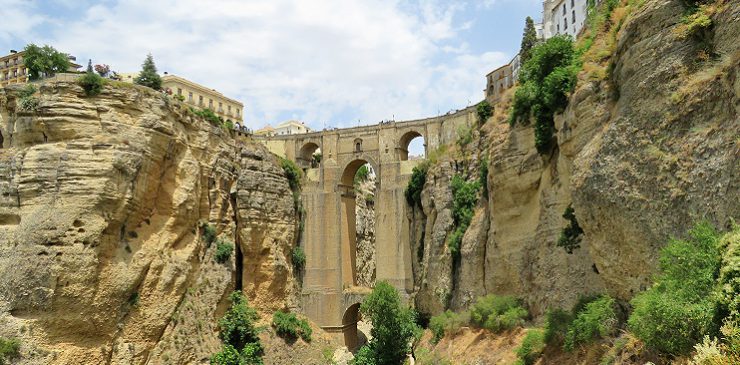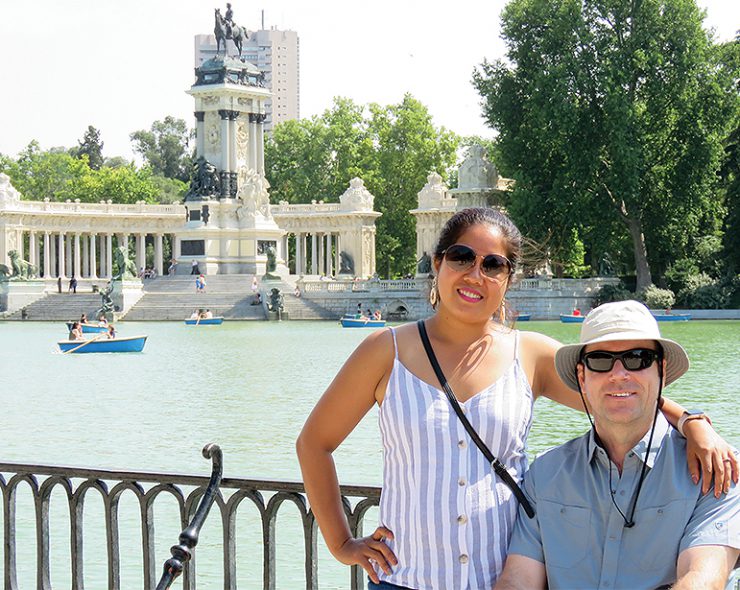Both the train and hotels had English-speaking customer service agents allowing me to book everything from Canada without the need for a travel agent, translator or tour company.
We arrived in Barcelona, the second largest city in Spain, located on the east coast in the Catalonia region. The city is filled with beautiful old Spanish architecture, it’s flat and most tourist attractions are centrally located so with a well-placed hotel you can easily get around using a wheelchair with minimal need for transportation. La Sagrada Famillia church, as well as several other buildings designed by Spanish architect Antoni Gaudí, were among the most popular attractions we saw. The beaches, cable car and mountaintop view from Tibidabo church were some of the highlights of our three days in Barcelona.
Our second stop was the capital city of Madrid in the centre of the country. Most of the attractions were just a short walk away like the Almudena Cathedral. Madrid was a little hillier than Barcelona but still a very wheelchair-friendly city to visit. Whenever we needed to go anywhere that was too far to walk, we just hailed a taxi because there was no UBER in Spain, but luckily the cab fares in all the cities we visited were much cheaper than in Toronto.
The third stop was the small city of Cordoba in southern Spanish region of Andalusia. The most picturesque sites were the Mosque-Cathedral and Roman Bridge of Cordoba. There we were in the oldest part of the city which had a lot of old, rounded cobble stones which proved to be the most challenging terrain I had encountered in Spain. On our second day I opted to bring my freewheel travel accessory for my manual wheelchair, to help get around as I had spent most of the previous day doing wheelies for hundreds of meters to avoid my small front wheels tripping up on the cobblestones.
Segovia is home to one of the world’s top ten Aqueducts. It is a magnificent structure built by the Romans over 1,800 years ago with two tiers of arches at its tallest point and was one of the two most impressive things we saw on this trip. Near the Cathedral of Segovia was the most beautiful church we saw on our trip and was atop a hill surrounded by the original historic town. Now a UNESCO world heritage site, the Alcazar de Segovia gave us a stunning view of the surrounding countryside. Our last stop was Spain’s fourth largest city, Seville, which sits to the west on the Guadalquivir River. Seville is home to the Alcázar Palace Complex, the Cathedral of Saint Mary of the Sea, and the stunning Plaza de España. We walked almost everywhere, and we were able to cover the city in two days, so we opted to take another day trip to the tiny city of Ronda, a mountaintop city in Spain’s Malaga province. Puente Nuevo, a stunning stone bridge spanning a deep gorge, was the second highlight of the whole vacation. Unfortunately, we only had a few hours to take in the city.
The big cities with their iconic buildings were the highpoint of our trip, the smaller cities that weren’t even on our itinerary ended up being the most beautiful places we saw. All the large cities we visited had accessible subway systems and buses though we never found cause to use them. With well situated hotels we were able to walk to most of the major tourist attractions. The narrow alleys between buildings provided plenty of cover to walk around in the day, and air-conditioned restaurants gave us a reprieve from the sun if it got too warm. The big cities had good wheelchair accessibility and it was only in smaller cities like Cordoba where I had any issues with cobblestones. Overall Spain had very good accessibility.
The last stop on the trip was Lisbon, the capital of Portugal. We flew TAP Air from Spain as they weren’t linked by rail. It quickly became apparent that Lisbon wasn’t going to be as accessible as Spain. All the sidewalks in Portugal are a wavy undulating mosaic of irregular shaped tiles. My freewheel device was invaluable to get around Lisbon, however the tiles were only half the problem. Lisbon is also known as the city of seven hills, and some sidewalks were so steep they had stairs integrated into them. Many sidewalks lacked curb cuts and several tourist attractions had stairs before or after the elevators. All these combined factors proved to be an immediate turn off as compared to the more accessible experience I had in Spain. If you plan on driving around everywhere or figuring out the public transit system you would be fine but if you’re like me and enjoy exploring a city on foot this might not be the place for you. The one saving grace was that Portugal had UBER and some of our rides were less than three Euros, however in the end I would have gladly swapped Lisbon for another city in Spain but the whole trip overall was fantastic.
Leandre Casselman is Fundraising Co-ordinator at SCIO’s Toronto office









